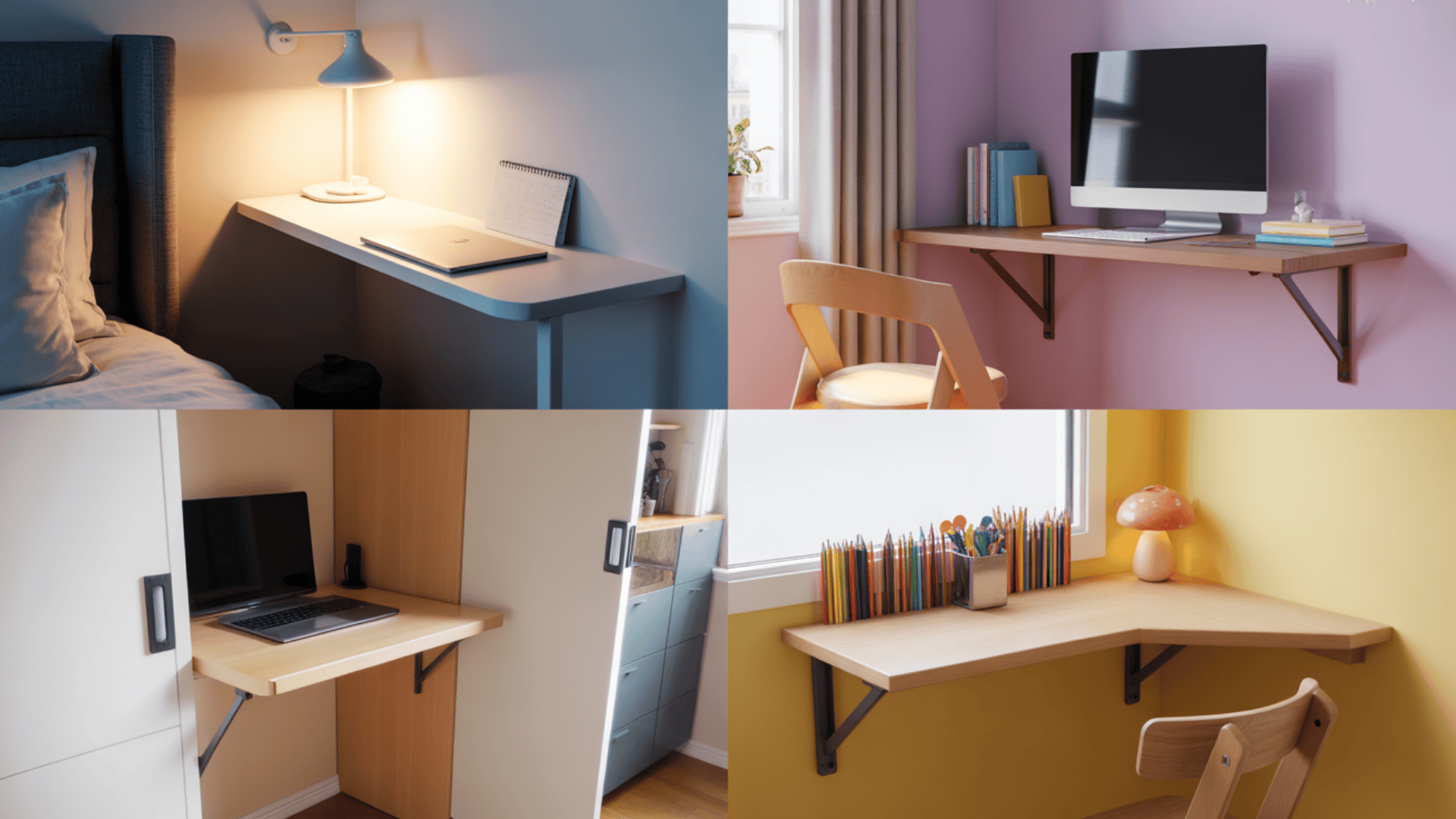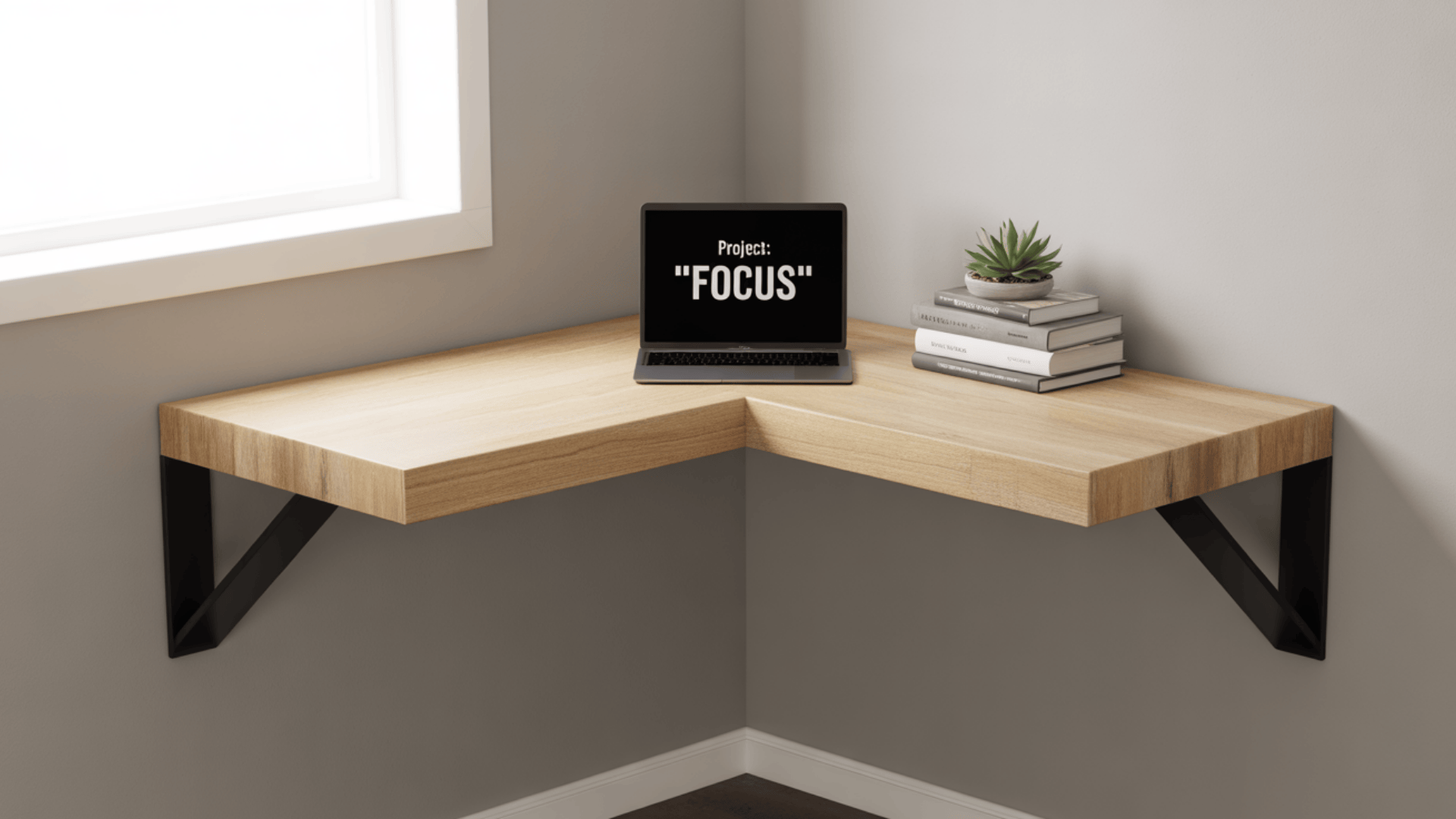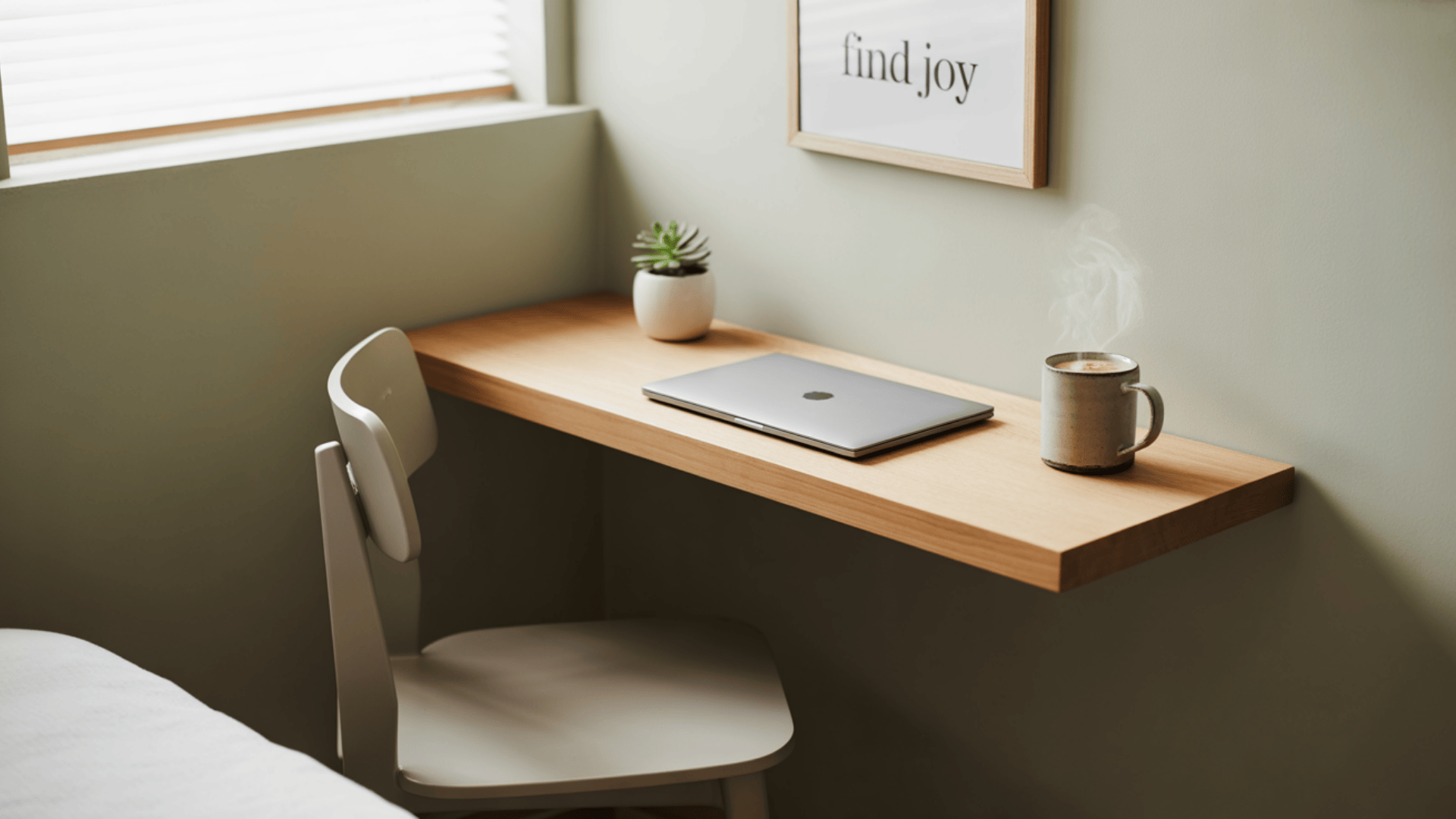A floating desk is a smart and simple choice for saving space.
Unlike regular desks, it attaches right to the wall and doesn’t have legs.
This keeps the floor open and makes the room feel bigger.
It’s a great option for small rooms, tight corners, or even closets turned into work areas.
People often choose floating desks when they need a spot to work but don’t have much space to spare.
These desks became more popular when more people started working or studying from home.
They’re easy to fit in bedrooms, hallways, or anywhere you need a quiet place to sit and focus.
Floating desks are also good for kids, teens, or adults since you can put them at any height.
Many styles are simple and match all kinds of rooms.
They also help keep clutter away and make it easier to clean the floor.
Overall, floating desks give you a neat and useful spot without taking over the room.
What Is a Floating Desk?
A floating desk is a wall-mounted desk with no legs.
It stays up with strong metal brackets or wall mounts.
Since it doesn’t touch the floor, it keeps the space below open, making a room look bigger and cleaner.
Beginning of Floating Desk
Over time, the way people work and live at home has changed.
More folks began working from home, and space became a big concern.
Not every home has a spare room, so people need smaller, smarter desk setups.
That’s when floating desks began to stand out as a smart solution.
They offered a way to add a work area without using too much floor space.
Following is a closer look at why so many people now love these desks and what makes them a good choice for different spaces.
Why People Like Floating Desks?
Floating desks are more than just space savers.
They offer helpful features that make them a top pick for many homes.
- Saves Space: These desks don’t use floor space, which helps in small rooms or apartments.
- Clean Design: With no legs or bulky parts, they match modern, simple room styles.
- Flexible Height: You can mount them higher or lower depending on your need, for kids, teens, or adults.
- Easy to Fit: Works well in bedrooms, hallways, entryways, or even closets turned into small work areas.
- Cost-Effective: Many floating desks use fewer parts and materials than full desks. This keeps the Cost down.
- Less Clutter: With no legs, cleaning the floor under the desk is much easier.
With so many benefits, it’s easy to see why floating desks are gaining attention.
They are functional without taking up too much room.
Types of Floating Desks

Floating desks aren’t all the same.
They come in different shapes and styles to match many rooms and needs.
Some stay fixed, while others fold away.
The following are the types of floating desks and what makes them stand out.
1. Wall-Mounted Models
If you want something simple and steady, wall-mounted floating desks are a good place to start.
These are the most common kind and are perfect for basic setups.
What Makes Them Stand Out
Wall-mounted desks are fixed straight to the wall.
They stay in place and don’t move or fold.
Their design is plain but useful.
Most are just a flat surface without drawers or shelves, making them great for light tasks like using a laptop or writing.
They’re best in places where you want a clean look and don’t need to move the desk around.
Since they don’t fold or adjust, these work well for long-term setups.
2. Bracket-Supported Designs
When you need more strength but still want to save space, bracket-supported floating desks are a great choice.
They offer solid support with a simple look.
What Makes Them Stand Out
These desks use strong brackets, metal or wood, to support the surface.
That gives them extra support compared to basic wall-mounted types.
Some can even hold books, small tools, or computer monitors.
Bracket desks are ideal for heavier use, like working with more than a laptop.
They also work well in shared spaces or places where the desk is frequently used.
3. Fold-Down/Convertible Options
This is the desk that hides when not in use.
Fold-down floating desks give you just that.
They’re great for small rooms or shared areas.
What Makes Them Stand Out
These desks fold up against the wall or a cabinet when not in use.
Some even have doors that close to hide the workspace.
You can fold them down to use, then tuck them away again.
They are perfect for multi-use rooms like bedrooms or kitchens, where you need the space back when the work is done.
Many fold-down types also come with small storage areas for pens or papers.
4. Corner Floating Desks
Sometimes corners are wasted space, but not with a corner floating desk.
These smart designs help turn unused areas into work zones.
What Makes Them Stand Out
Corner floating desks are shaped to fit neatly into corners.
They often come with two surfaces joined at an angle, giving more space without taking over the room.
These are great for kids’ rooms, home offices, or even living rooms where space is tight.
They also work well for people who want to keep their main walls clear or decorate around the desk.
Cost Analysis
Floating desks are available in many price ranges.
The price depends on the size, design, materials, and added parts like drawers or shelves.
Below is a breakdown to help you compare.
| RANGE | PRICE | WHAT YOU GET |
|---|---|---|
| Budget | $50–$150 | Basic styles with plain parts, small surface, no extras |
| Mid-range | $150–$300 | Larger surface, better materials, and some storage included |
| Premium | $300+ | Custom pieces, strong builds, extra features, or shelves |
Price factors depend on various things like:
- Material Type: Wood, metal, or mixed parts
- Size: Bigger desks cost more
- Added Parts: Drawers, shelves, or plug-in spots
- Brand Name: Well-known makers may charge more
You don’t have to spend a lot to get a good desk.
Budget models work fine for simple tasks.
Mid-range choices are a good fit if you need more space or storage.
Fancy or custom styles cost more but add special features.
5 Easy DIY Floating Desk Ideas for Any Room
Building your floating desk is a smart way to save money and fit your space just right.
These desks are easy to make with simple tools and parts.
Below are five desk ideas you can build at home.
DIY 1: Basic Wall Bracket Desk

A simple wall-mounted desk that’s perfect for small rooms or apartments.
It takes up little space but still gives you a strong, useful surface.
Materials Needed
- One wood board (about 40″ x 18″)
- 2–3 heavy-duty wall brackets
- Screws and wall anchors
- Drill
- Level
- Stud finder
- Screwdriver
Step-by-Step
- Use the stud finder to mark where the brackets will go.
- Drill the brackets into the wall studs.
- Place the wood board on top of the brackets.
- Screw the board into the brackets from underneath.
Cost Breakdown: $50-$75.
DIY 2: Fold-Down Wall Desk

Want a desk that folds away when you don’t need it?
This wall-mounted design saves floor space and folds flat when it’s not in use.
Materials Needed
- Flat plywood board
- Two folding shelf brackets
- Hinges
- Wall anchors and screws
- Screwdriver
- Drill
- Level
- Measuring tape
Step-by-Step
- Attach folding brackets to the wall at desk height.
- Screw the board to the top of the brackets.
- Add hinges if needed for extra folding support.
- Test the fold-down and lock positions.
Cost Breakdown: $60-$90
DIY 3: Corner Floating Desk

This design fits neatly into a corner, turning space into a smart desk area.
Great for rooms where every inch counts.
Materials Needed
- Two wood boards (cut to fit the corner)
- L-shaped wall brackets
- Screws and wall anchors
- Saw
- Drill
- Level
- Stud finder
Step-by-Step
- Measure and cut wood to fit your corner.
- Find wall studs and attach L-brackets.
- Secure both boards onto the brackets.
- Sand and finish the surface if needed.
Cost Breakdown: $70-$100
DIY 4: Floating Desk With Shelf

This one gives you both a workspace and a shelf above it for books or decor.
It’s a great pick if you need more room to keep things organized.
Materials Needed
- Large wood desktop
- Smaller board for the shelf
- 4–5 brackets (2 for shelf, 2–3 for desk)
- Screws and anchors
- Drill
- Level
- Stud finder
- Screwdriver
Step-by-Step
- Install lower brackets and attach the desk.
- Place shelf brackets above the desk.
- Screw the shelf into the brackets.
- Make sure both are level and steady.
Cost Breakdown: $80-$120
DIY 5: Kids’ Floating Homework Desk

A kid-sized wall desk that’s fun, sturdy, and just the right size for homework or art time.
You can decorate it for extra charm.
Materials Needed
- Small wood board
- Two sturdy brackets
- Paint or stickers (optional for design)
- Screws and anchors
Tools Required
- Drill
- Level
- Screwdriver
- Stud finder
Step-by-Step
- Choose a kid-friendly desk height.
- Mark the studs and place the brackets.
- Screw the board into the brackets.
- Decorate if you want a fun look.
Cost Breakdown: $40-$60
Floating Desks vs. Traditional Desks
Floating and regular desks each have strengths.
Your choice depends on your room size, how often you move furniture, and what style fits your home.
This table shows how the two types compare in important areas like space, price, and support.
| FEATURE | FLOATING DESK | TRADITIONAL DESK |
|---|---|---|
| Floor Space | Uses the wall, keeps the floor clear | Takes up floor space |
| Price Range | Often lower, fewer parts needed | Can cost more, more material, and size |
| Support and Strength | Needs a strong wall and parts | Stands on legs, holds more weight |
| Look and Feel | Clean and simple, good for tight spaces | Comes in many styles and shapes |
| Moveability | Stays in place, not easy to move | Can be moved or placed anywhere |
If your room is small or you want a clean look, floating desks work well.
But if you need something that holds more or can move around, a regular desk might be a better choice.
Maintenance & Care
To keep your floating desk in good shape, clean it often and check that it stays strong.
Wipe the surface with a soft cloth and mild soap if needed.
Don’t let dust or stains build up.
Do not place items that are too heavy on the desk—always follow the weight limit given by the maker.
Every few months, check the wall screws and brackets.
Tighten them if they feel loose to keep the desk safe and steady.
Conclusion
Floating desks are a smart way to make the most of small spaces.
They mount directly to the wall, saving floor space and creating a clean, open look.
Whether you need a desk for work, study, or hobbies, these setups fit easily into bedrooms, hallways, or even closets.
With different styles, such as fold-down, corner, or shelf-added designs, there’s a floating desk for every need.
They’re also budget-friendly and simple to install.
Maintenance is easy, and with the right setup, they can last for years.
A floating desk is a smart choice if you want a neat, useful workspace that does not take up much room.
It’s one of the simplest ways to add function without giving up space or style.








